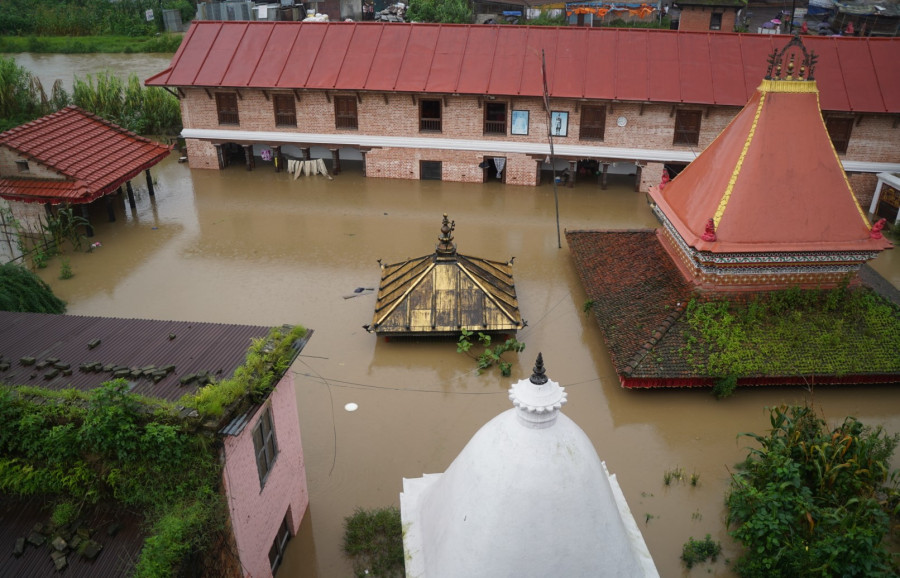Columns
Poor urban planning and floods
Adaptive planning of green and grey infrastructure can enhance urban resilience to extreme rainfall and flooding.
Sanjib Sharma
Extensive flooding in Kathmandu Valley in recent days demonstrates how exposed and vulnerable our urban system is, even to non-extreme rainfall events. The consequences are devastating, with immense economic damages and cascading impacts on critical urban services, including transportation, water supply, electricity, schools and hospitals. The situation is complicated by poor urban planning, deteriorating infrastructure and changing environmental conditions.
Monsoon is a seasonal wind system that brings heavy rainfall to the Indian subcontinent. During this period, the landmass heats up more rapidly than the surrounding oceans, creating a low-pressure zone over the region. As a result, moist air from the Indian Ocean is drawn towards the land, carrying abundant moisture and resulting in heavy rainfall over Nepal and neighbouring countries. Monsoon is likely to become stronger and less predictable due to climate change and global warming.
As cities expand and develop, natural landscapes are replaced by impervious materials such as concrete, asphalt and buildings. During heavy rainfall, water rapidly flows over the highly impervious surface. In addition, the urban temperature is often a few degrees higher than surrounding areas, a phenomenon known as the urban heat island effect. Urban areas also contribute to the production of particles, commonly called aerosols, that enter the atmosphere and influence regional rainfall patterns through their interactions with clouds and radiation. The integrated impacts of monsoon rain, urban imperviousness and city landscapes can lead to floods.
Moreover, an inadequate drainage system exacerbates flood risk. Heavy rainfall overwhelms the drainage network, causing water to accumulate on the streets, residential areas and public spaces. The existing drainage systems, originally designed to meet historical urban demands, are no longer sufficient to handle the challenges posed by increasing urbanisation and evolving climate extremes. Traditional combined sewer systems convey wastewater and surface runoff in the same drainage network and the volume of water can exceed its capacity, leading to overflows during heavy rainfalls. These overflows can discharge untreated wastewater and stormwater directly into nearby water bodies, causing water pollution and potential health hazards.
The expansion of settlements along the rivers has restricted their natural flow. River encroachment has led to the narrowing of river channels, which hampers the water's ability to disperse efficiently, exacerbating the risk of flooding.
Flooding can happen away from the river. Surface water floods occur when runoff from intense precipitation exceeds the capacity of drainage systems. Several regions experience flooding through the combination of surface runoff and the overflowing of nearby rivers or streams. These two factors aggravate potential damages when they occur simultaneously or in close succession.
Urban flood risk
Due to the inefficient drainage system, waterlogging becomes a common occurrence in urban areas, trapping rainwater in low-lying areas and on roads. Waterlogging leads to traffic congestion, hindering movement within the city and causing inconvenience to pedestrians.
The stagnant water, thanks to the inadequate drainage system, becomes a breeding ground for mosquitoes and other disease-carrying vectors. This increases the risk of waterborne diseases, such as dengue, malaria and cholera, significantly threatening public health. During the recent 2022 dengue outbreak, at least 50 people died, infecting over 45,000 people across the country.
The ineffective drainage system also has adverse effects on the environment. The polluted rainwater, combined with wastewater and sewage, often ends up in rivers and water bodies, contaminating them and causing ecological damage. The lack of proper wastewater management leads to water pollution, affecting aquatic life and biodiversity.
Continuous exposure to waterlogging and flooding damages roads, buildings and other infrastructure components. In 2019, the estimated cost of rain damage to roads and bridges exceeded Rs 2 billion. Excessive water weakens the foundation of structures, leading to cracks, collapses, and long-term structural issues. The cost of repairing and maintaining impacted infrastructure often exceeds our available resources.
Heavy rainfall significantly damages hydropower plants, electricity wires, utility poles and power stations. This can result in widespread power outages, affecting even critical services like hospitals and schools, as well as residential areas and businesses. Power outages, especially during hot summer days, can lead to devastating heat impacts, threatening the public’s health and well-being.
Next generation infrastructure
Significant investment is necessary to construct next-generation infrastructure, which plays a crucial role in maintaining national economic growth, addressing poverty and mitigating climate impacts. Investments must be directed towards enhancing the capacity and efficiency of the existing infrastructure. Regular clearing and maintenance of drains and waterways are essential to ensure their proper functioning. Removing debris, silt and other obstructions from drains significantly improves the drainage system’s efficiency. Encouraging responsible waste disposal practices and community involvement in keeping drains clear can help alleviate the issue.
Effective urban planning is crucial for incorporating proper drainage systems into new construction projects. Implementing building codes that include provisions for drainage infrastructure can prevent the exacerbation of the problem.
Green infrastructure, such as rainwater harvesting, rain gardens, retention ponds and permeable pavements, can help reduce the burden on the drainage system. Floodplains and wetlands act as natural buffers. These non-structural measures absorb and store excess water, reduce runoff intensity and peak flows, and provide a range of ecosystem services. Integrating these nature-based solutions into mainstream infrastructure systems can enhance infrastructure resilience to extreme events.
Adaptive planning
Constructing new infrastructure can be expensive. Urban spaces are often limited, leaving little room for accommodating new infrastructure. Innovative integration of green infrastructure with traditional human-engineered grey infrastructure could potentially meet flood management needs without expensive overbuilding. It is crucial to identify the most appropriate combination of green and grey solutions considering the dynamic urban land use, socioeconomic factors and climatic conditions. Moreover, the utmost importance should be the vulnerable areas and communities to enhance the overall effectiveness of flood management efforts.
Decision-makers and stakeholders must strategically explore when and how flood risk management strategies should be adjusted, considering operational changes, policy adjustments, and/or infrastructure development. It is imperative to prioritise robust decisions that satisfy the objectives of decision makers and stakeholders in many plausible futures rather than being optimal in a single purpose for a specific timeframe. Developing a resilient next-generation infrastructure system requires coordination of the government, local authorities and communities.
Adaptive planning, involving some adaptive measures now and adding more in the future if needed, has the potential to enable robustness in an uncertain future. Strategies for capturing rainwater can be initially implemented with the incremental expansion of drainage pipes each year. If the evidence suggests higher risks in the future, subsequent efforts can focus on elevating homes or managing groundwater, particularly in vulnerable areas. Eventually, this will result in lower costs without unnecessary infrastructure development or policy changes.
Sharma is an assistant professor at Howard University in Washington, DC, USA. His research interests include hydrology and water resources.




 11.12°C Kathmandu
11.12°C Kathmandu















